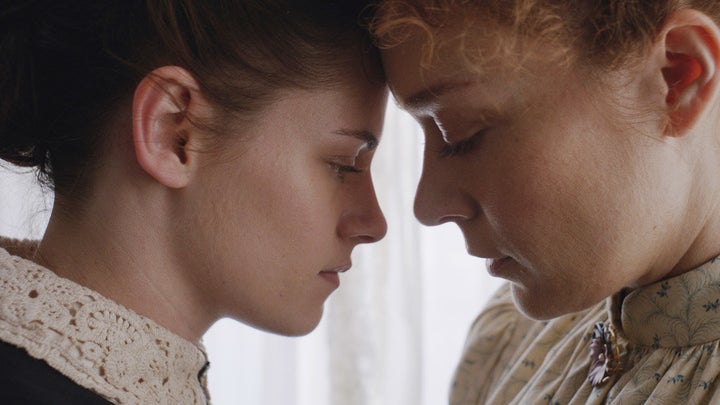
The tale of Lizzie Borden has been axed to death, just like her father and stepmother. And yet, on Friday, another dramatization of the alleged killer’s cloistered 19th-century life premiered at the Sundance Film Festival.
“Lizzie” has been Chloë Sevigny’s passion project since 2010. And who is a better fit to play Borden than Sevigny, best known for dark roles and cool-girl eccentricities? But the movie underwent a circuitous route to the big screen ― one that wasn’t as serendipitous as the actress hoped.
Sevigny was first inspired to develop the film when an artist friend of hers ― Lily Ludlow, whom Sevigny described as “esoteric” and “witchy” ― dressed as Lizzie Borden for Halloween. Taken with the imagery of this Gilded Age commoner who suffered fainting spells and fantasized about escaping her stodgy parents, Sevigny did her research, delving into Borden’s past as a tried ― and acquitted ― ax murderer from Fall River, Massachusetts. Sevigny, along with screenwriter Bryce Kass, quickly mounted a film project, transforming it into a miniseries in order to get a greenlight from HBO, where she was nearing the end of her employment on the drama “Big Love.”
“So much has been said [about Borden]. But I think that we just really wanted to focus on how she went about finding [her freedom] and how important that was to her and what that meant to her,” Sevigny told me at Sundance. “Whether it was through the relationship with [her maid] or ultimately killing her parents for money ― because money equaled freedom then. It still does. I wanted it to be this rousing, smash-the-patriarchy piece, and then she gets everything she wants monetarily — the capitalist dream. She gets the house on the hill, and Bridget leaves her. Her sister leaves her. She ends up alone.”
Seven years later, the movie that premiered at Sundance was not what Sevigny conceptualized. According to her, HBO dawdled on the film’s production, and when the powers that be finally opted to move forward, they were scooped by Lifetime, which released “The Lizzie Borden Chronicles,” a TV movie starring Christina Ricci, in January 2014. As a result, HBO pulled the plug.
“You can’t imagine how heartbroken I was,” Sevigny said. “I was really like, I can’t go on. This is the end of days for me. It was an emotional roller coaster.”
Sevigny and Kass, who’d partnered with Tom Hanks’ production company, had to retrieve the rights to the script from HBO, after which Kass culled the four-hour miniseries into the feature film he and Sevigny first envisaged, which would convey an erotic relationship between Lizzie and her family’s Irish live-in maid, Bridget Sullivan, portrayed with shy sensitivity by Kristen Stewart. Sevigny and Kass quickly lined up producers. The first director who signed on, Pieter Van Hees, dropped out due to scheduling conflicts. Craig William Macneill, who made the 2015 thriller “The Boy,” replaced him, but Sevigny said he had his own ideas about how to frame Borden’s story.
Sevigny was hoping for “Black Swan” meets “Capote.” But on set and in the editing process, Macneill apparently trimmed and expunged scenes, including some of Sevigny’s punchier moments ― for example, “exclamation points” ending heated exchanges with Borden’s parents, played by Jamey Sheridan and Fiona Shaw. More crushingly, some of the development surrounding Lizzie and Bridget’s affair was left on the cutting-room floor. As we see it, their flirtations are sensual but clipped.
“I love the whole murder sequence ... seeing the ax in the bin. I think there’s some real beautiful work that [director Craig William Macneill] did, and dare I say elegant?”
“It was very hard,” Sevigny said about learning those moments weren’t included in the film. “I was like, ‘If you have another scene with Kristen Stewart and you don’t put it in your movie, you’re stupid. What’s your problem?’ But almost every movie goes through that. Almost everything that was on the page was filmed, and a lot of it didn’t make it in the movie. And more stuff with me and Fiona Shaw. There was more to the relationships that made them more complicated, and also then informed why Lizzie [commits the murders]. Now it’s a little more vague than what Bryce and I intended originally to do.”
Asked whether she could elaborate on how the film’s tone and content changed, Sevigny said, “Without getting in trouble, probably not,” laughing and looking around to see if her publicist was in the room.
“I think Craig is very restrained,” she continued. “Craig has a lot of vision. I think he’s a great filmmaker. But I think maybe the movie could so easily go camp because she is also a camp figure. I think he was very frightened of pushing emotion in that direction, where it might turn into that. So he was really pulling the reins on a lot, performance-wise. [...] What was so much harder with this film was I was a producer and this was my baby. I developed it from the get-go, and I had to relinquish control and power over to the other producers and the director. That was my first experience in that. Of course I’ve been in countless other movies where scenes all of a sudden disappear. You’re like, all right, well, that happens. But because I was so close to the material, it became harder for me to let go of stuff.”
“But we hired him,” she added, “and this was his vision and this was his interpretation of what we gave him.”
As it exists, “Lizzie” remains rather external ― it’s not as “inside her head” as Sevigny hoped. As much a romance as it is a psychodrama, the movie features more than a few shots of Lizzie’s backside as she glides through her yard and home. When asked whether she was surprised there weren’t more closeups of her face, which might better telegraph Lizzie’s internal emotions, Sevigny chuckled.
“You’re really pushing this,” she said. “I mean, have you been on my email chain? Uh-oh, I’m getting dirty looks [from my publicist]. Yes.”
It seems the film’s evolution surprised Macneill, too. He told Filmmaker magazine that the budget prevented “Lizzie” from shooting in New England, where Borden lived from 1860 until her death in 1927. “As a result, we were forced to mostly suggest the outside world rather than showing it,” he said. “Consequently, most of the film takes place inside the Borden home. As it turned out, finding a suitable interior was nearly as complicated as finding exterior locations, and each day without a locked location put an enormous strain on every department.”
For what it’s worth, the movie springs to life during the culminating murder sequence, in which Lizzie, fully nude so as to avoid incriminating bloodstains, slowly climbs the stairs, wielding the ax she’ll use to bludgeon her patronizing father and unloving stepmother. Exactly how much of Sevigny’s body would be exposed ― read: a lot of it ― was contractually negotiated via her agents and the movie’s producers. She also approved the footage after it was shot.
“I still feel really vulnerable, like I put myself out there,” she said. “I’m hoping it’s worth it.”
Indeed, the execution is dripping with carnal moxie. It’s the payoff we desire for someone trapped by her parents’ command, a woman who wasn’t even permitted to go into town unaccompanied.
“I love the whole murder sequence,” she said. “And even the stiller shots, just seeing the ax in the bin. I think there’s some real beautiful work that [Craig] did, and dare I say elegant? [...] You almost want her to have this cathartic moment. It’s sexual.”
